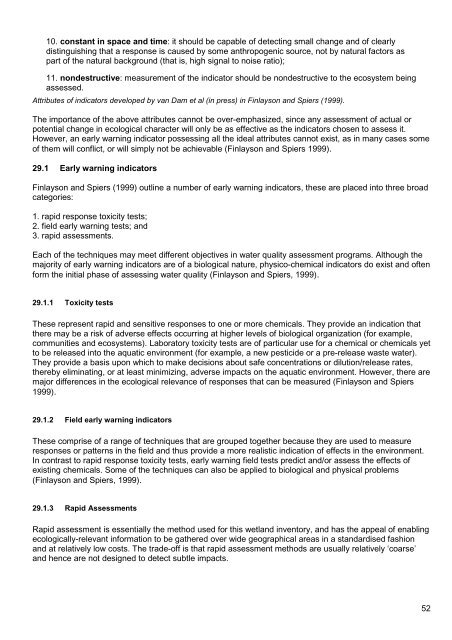2007 Wetland Inventory for the Eyre Peninsula
2007 Wetland Inventory for the Eyre Peninsula
2007 Wetland Inventory for the Eyre Peninsula
- No tags were found...
Create successful ePaper yourself
Turn your PDF publications into a flip-book with our unique Google optimized e-Paper software.
10. constant in space and time: it should be capable of detecting small change and of clearlydistinguishing that a response is caused by some anthropogenic source, not by natural factors aspart of <strong>the</strong> natural background (that is, high signal to noise ratio);11. nondestructive: measurement of <strong>the</strong> indicator should be nondestructive to <strong>the</strong> ecosystem beingassessed.Attributes of indicators developed by van Dam et al (in press) in Finlayson and Spiers (1999).The importance of <strong>the</strong> above attributes cannot be over-emphasized, since any assessment of actual orpotential change in ecological character will only be as effective as <strong>the</strong> indicators chosen to assess it.However, an early warning indicator possessing all <strong>the</strong> ideal attributes cannot exist, as in many cases someof <strong>the</strong>m will conflict, or will simply not be achievable (Finlayson and Spiers 1999).29.1 Early warning indicatorsFinlayson and Spiers (1999) outline a number of early warning indicators, <strong>the</strong>se are placed into three broadcategories:1. rapid response toxicity tests;2. field early warning tests; and3. rapid assessments.Each of <strong>the</strong> techniques may meet different objectives in water quality assessment programs. Although <strong>the</strong>majority of early warning indicators are of a biological nature, physico-chemical indicators do exist and often<strong>for</strong>m <strong>the</strong> initial phase of assessing water quality (Finlayson and Spiers, 1999).29.1.1 Toxicity testsThese represent rapid and sensitive responses to one or more chemicals. They provide an indication that<strong>the</strong>re may be a risk of adverse effects occurring at higher levels of biological organization (<strong>for</strong> example,communities and ecosystems). Laboratory toxicity tests are of particular use <strong>for</strong> a chemical or chemicals yetto be released into <strong>the</strong> aquatic environment (<strong>for</strong> example, a new pesticide or a pre-release waste water).They provide a basis upon which to make decisions about safe concentrations or dilution/release rates,<strong>the</strong>reby eliminating, or at least minimizing, adverse impacts on <strong>the</strong> aquatic environment. However, <strong>the</strong>re aremajor differences in <strong>the</strong> ecological relevance of responses that can be measured (Finlayson and Spiers1999).29.1.2 Field early warning indicatorsThese comprise of a range of techniques that are grouped toge<strong>the</strong>r because <strong>the</strong>y are used to measureresponses or patterns in <strong>the</strong> field and thus provide a more realistic indication of effects in <strong>the</strong> environment.In contrast to rapid response toxicity tests, early warning field tests predict and/or assess <strong>the</strong> effects ofexisting chemicals. Some of <strong>the</strong> techniques can also be applied to biological and physical problems(Finlayson and Spiers, 1999).29.1.3 Rapid AssessmentsRapid assessment is essentially <strong>the</strong> method used <strong>for</strong> this wetland inventory, and has <strong>the</strong> appeal of enablingecologically-relevant in<strong>for</strong>mation to be ga<strong>the</strong>red over wide geographical areas in a standardised fashionand at relatively low costs. The trade-off is that rapid assessment methods are usually relatively ‘coarse’and hence are not designed to detect subtle impacts.52
















